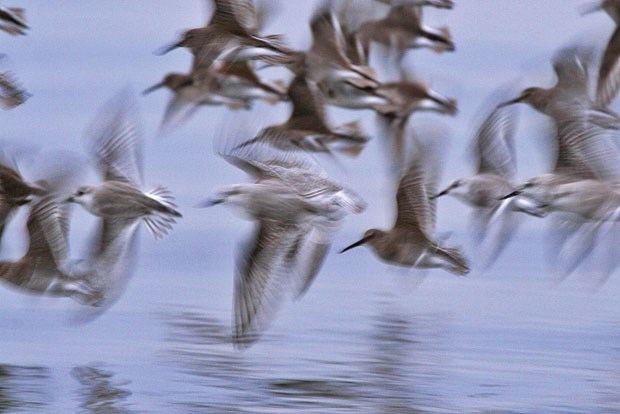The Port of Vancouver is continuing its field studies as part of its ongoing environmental technical work for the Container Capacity Improvement Program.
Examining, among other things, biofilm, biologists this month are collecting samples from the Roberts Bank upper tidal zone. They’ll analyze the samples for biofilm species composition and indicators of nutritional value to shorebirds. The port notes abiotic parameters, such as temperatures, salinity and depth, will be monitored at the sampling locations.
The Container Improvement Program includes infrastructure work that is part of the Deltaport Terminal, Road and Rail Improvement Project, as well as the proposed Terminal 2 project that is at the federal review stage.
The biofilm issue has been a hotly contentious one for opponents of the T2 expansion plan, who note mudflats at Roberts Bank provide a unique feeding area for upwards of 600,000 migrating Western Sandpipers and 200,000 Dunlin.
“They rely on the rich nutrients found in biofilm in the mudflats at Roberts Bank. The area is unparalleled on the West Coast due to the perfect mix of reduced salinity, nutrients from the Fraser River, low tides, and warmer spring temperature which provide the perfect conditions for tiny diatoms to produce omega-3 fatty acids just as the sandpipers migrate through this area,” says Against Port Expansion (APE).
Without the mudflats, the whole migratory flock, including one of the most important Western Sandpiper flocks in the world, could never make it to the Arctic, APE warns.
In its submission to the federal environmental review panel looking at T2, the Corporation of Delta also raised concern about the issue.
“Regarding the critical inter-relationship between shore birds and biofilm, Delta is concerned by the Proponent’s conclusion that ‘biofilm composition is expected to change temporarily during freshet in response to decreases in salinity, and return to existing conditions outside of the annual freshet period’, particularly given Environment Canada’s comment that ‘Recent work on Roberts Bank by international scientists has provided new information on the nature of the intertidal diatom community...’ This new information casts reasonable doubt on some of the Proponent’s key conclusions with respect to biofilm and migratory birds,” states Delta’s submission.
The municipality also noted that the results of the Adaptive Management Strategy for the Deltaport Third Berth project were generally positive in that significant adverse environmental trends were not identified. However, the geographic extent of that study was limited to the inter-causeway area and does not provide any reassurance regarding potential impacts of RBT2 north wards of the Deltaport causeway where impacts would be expected to be greatest.
In a project update two years ago, the port concluded, “Our assessment has concluded that feeding opportunities for birds would not be significantly affected after the construction of the new terminal.”



